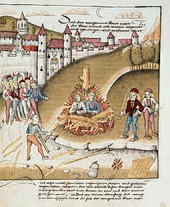Swiss illustrated chronicle



The Swiss illustrated chronicles are a group of parchment and paper manuscripts from the late 15th and early 16th centuries that document the rise of the Confederation , the military successes and the rise of the Swiss Confederation to a political power in Europe for the urban elite. The well-known techniques of letterpress and woodcut were dispensed with for the production and the manuscripts were hoarded as great treasures.
The forerunner of these chronicles is the original Bern Chronicle , which was commissioned in 1420 by the councilor Konrad Justinger and which deals with events up to 1423. The later chroniclers mostly adopted Justinger's descriptions almost literally. A copy has been preserved in Jena , which seems to leave room for illustrations, so that it is possible that Justinger's chronicle could already be counted among the pictorial chronicles.
The oldest surviving illustrated chronicle is the Tschachtlan chronicle from 1470 by the Bernese councilors Benedict Tschachtlan and Heinrich Dittlinger , a paper manuscript with 230 illustrations, today kept in the Zurich Central Library . For the period after 1423 it is based on the chronicle of Hans Fründ from Schwyz (for the time of the Old Zurich War ) and probably on an early work by the older Diebold Schilling, who had been in Bern since 1460. Of the 230 illustrations in the Tschachtlan Chronicle, 200 depict war scenes, some of them with tiring monotony.
The Bern Chronicle of Diebold Schilling the Elder was probably commissioned in 1474, to the monstrous events of the Burgundian Wars documented. The Spiezer Chronik was created following the Official Chronicle and contains an abbreviated text version. The large Burgundy chronicle of the elder Schilling is now kept in the Zurich Central Library. It is possibly based on an uncensored version of the Official Chronicle and was extended to cover the years 1480–1484.
Diebold Schilling the Younger was the son of Hans Schilling and brother of the older Diebold. His chronicle, the Lucerne Chronicle , he presented the Council of the city of Lucerne on 15 January 1513. Politically the younger Schilling his uncle diametrically opposite, he denounces the pro-French policy of the Swiss, especially the Bernese, and the printed chronicle by the Lucerne Petermann Etterlin from 1507 and instead tends towards the Habsburg Maximilian who personally invited him to the Reichstag in Constance in 1507. About 30 percent of the images also report on “miscellaneous things” such as crime, accidents and magic.
The Swiss Federal Chronicle , the youngest of the Swiss illustrated chronicles, was created around 1502 and comes from the Bremgartner chronicler Werner Schodoler . Its sources are primarily the Bernese Schilling and Etterlin's printed chronicle. He reports independently for the period after 1511; his description of the Italian wars is probably based on his own experience.
The collections of Christoph Silberysen (1576) and Johann Jakob Wick (" Wickiana ", 1587) can be seen as latecomers . Johannes Stumpf (1547/1548) also successfully transferred the tradition of the illustrated chronicles to print .
literature
- Carl Pfaff : The world of Swiss picture chronicles . Schwyz 1991.
Web links
- Carl Pfaff: picture chronicles. In: Historical Lexicon of Switzerland .